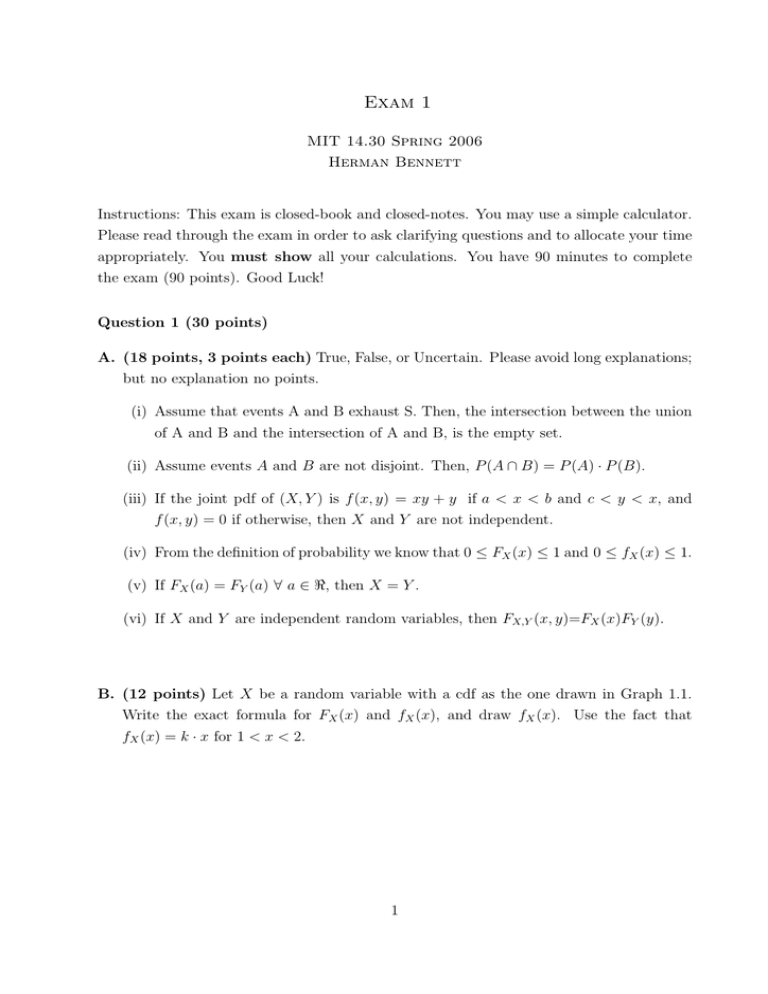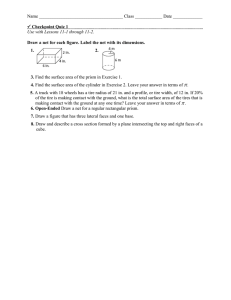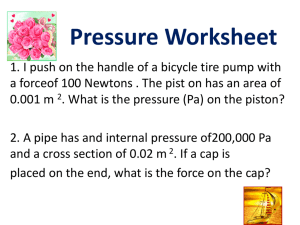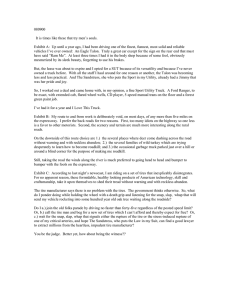Exam 1
advertisement

Exam 1 MIT 14.30 Spring 2006 Herman Bennett Instructions: This exam is closed-book and closed-notes. You may use a simple calculator. Please read through the exam in order to ask clarifying questions and to allocate your time appropriately. You must show all your calculations. You have 90 minutes to complete the exam (90 points). Good Luck! Question 1 (30 points) A. (18 points, 3 points each) True, False, or Uncertain. Please avoid long explanations; but no explanation no points. (i) Assume that events A and B exhaust S. Then, the intersection between the union of A and B and the intersection of A and B, is the empty set. (ii) Assume events A and B are not disjoint. Then, P (A ∩ B) = P (A) · P (B). (iii) If the joint pdf of (X, Y ) is f (x, y) = xy + y if a < x < b and c < y < x, and f (x, y) = 0 if otherwise, then X and Y are not independent. (iv) From the definition of probability we know that 0 ≤ FX (x) ≤ 1 and 0 ≤ fX (x) ≤ 1. (v) If FX (a) = FY (a) ∀ a ∈ �, then X = Y . (vi) If X and Y are independent random variables, then FX,Y (x, y)=FX (x)FY (y). B. (12 points) Let X be a random variable with a cdf as the one drawn in Graph 1.1. Write the exact formula for FX (x) and fX (x), and draw fX (x). Use the fact that fX (x) = k · x for 1 < x < 2. 1 Herman Bennett Exam 1—MIT 14.30 Spring 06 Question 2 (15 points) Suppose there are 15 MIT students (10 of them women), 30 Harvard students (15 of them women), and 36 BU students (10 of them women). (i) (5 points) In how many ways can you form a committee of 8 students, if 3 of them have to be from MIT, 2 from Harvard, and 3 from BU? (ii) (5 points) Assume now that the students are chosen randomly without quotas. What is the probability of choosing a committee of 8 students where 2 are women? (iii) (5 points) In how many ways can you split the students in three groups such that each group contains 5 MIT, 10 Harvard, and 12 BU students? 2 Herman Bennett Exam 1—MIT 14.30 Spring 06 Question 3 (20 points) A pharmaceutical company launched a new herbal product, MOREMATHTM , which it claims can improve people’s math skills. In particular, the company claims that MOREMATHTM increases a person’s math skills 80% of the time and that it has no effect 20% of the time. Doctor Testing would like to test this claim. He randomly chooses a group of 20 students and makes them answer an algebra exam. Then, he gives MOREMATHTM to each of them and makes them answer a completely different algebra exam. The results: 16 out of the 20 students did better in the second exam. Assume i) no learning between exams and ii) that if a student increases its skill it will score higher, but if it doesn’t increase its skill it has 50% chance of getting a higher score and 50% chance of getting a lower score. (i) (3 points) What is the probability of finding what Doctor Testing found if the claim of the pharmaceutical company is true? (ii) (3 points) What is the probability of finding what Doctor Testing found if the claim of the pharmaceutical company is not true (that is, MOREMATHTM has no effect on students’ performance)? (iii) (8 points) Assume that before running the experiment Doctor Testing believed that it was equally likely that the claim was true or false. What should be the new belief of Doctor Testing regarding the trueness of the company’s claim? (iv) (6 points) After completing the study, a student asks Dr. Testing about the likeli­ hood of improving her math skills by taking MOREMATHTM . What is Dr. Testing’s belief about the probability that the student’s math skill will improve with MOREMATHTM after conducting the experiment? 3 Herman Bennett Exam 1—MIT 14.30 Spring 06 Question 4 (25 points) The pressure level on the right and left tire of a car, measured in psi, is represented by the random variables X and Y , respectively. Let f (x, y) represent the joint pdf of X and Y , where k > 0. � f (x, y) = k · (x2 + yx) if 10 < x < 40 and 10 < y < 40 0 otherwise. (i) (3 points) Find k. (ii) (3 points) What is the probability that both tires have between 20 and 30psi? (iii) (3 points) What is the probability that the right tire has more pressure than the left tire? (iv) (8 points) Find the marginal distribution of the pressure in the right tire and the conditional distribution of the pressure in the right tire given the pressure in the left tire. Does knowing the pressure in the left tire change the probability assessment about the pressure level in the right tire? In light of this, is the pressure in the left tire independent of the pressure in the right tire? (v) (8 points) The manufacturer’s recommendations state that the tires should not have together more than 40psi and that the difference between the tires should not exceed 1 psi. What is the probability that the tires’ pressure level follows the recommendations of the manufacturer? Note: You do not need to solve the integrals in parts (ii), (iii), and (v). Do not forget the limits of integration. 4





